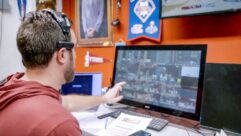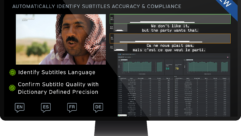Every Day’s a Fall SaturdayThe College Football Hall of Fame uses interactive video and talking statues to recreate the feel of a football stadium on a sunny autumn afternoon.
May 20, 1996 12:00 PM,
Toni Flosi
The new National College Football Hall of Fame has been created as much more than a place to view bronze plaques and grainy films of gridiron heroes of the past.
The sparkling new facility in downtown South Bend, IN, draws patrons into the college football experience with meticulously planned and executed interactive displays and exhibits. Several years in the planning, the Hall of Fame is the result of the combined talents of numerous groups and people.
The selection of South Bend seems a natural: It’s the home of The University of Notre Dame, which fields the most popular college football team in the land. In fact, South Bend was named “top college football town” in 1995 by The Sporting News. The city is also located immediately off Interstate 80, the major east-west route in the northern United States.
The National Football Foundation selected the site from a field of 50 cities, with the short list narrowed to South Bend vs. four major metropolises: Atlanta, Houston, Memphis and New Orleans. Two factors tilted the decision to the Indiana heartland. First, civic leaders put together an impressive support package, part of which was a provision for connecting the Hall of Fame via an underground tunnel to the adjacent Century Center, a convention facility that provides extra space and flexibility for hall-sponsored events. Second, the previous location, Kings Island, OH, had detracted attendance and interest. In South Bend, the College Football Hall of Fame is one of the biggest shows in town.
The city took on a lion’s share of administrative and organizational responsibilities in the project. One of its primary criteria was to use as much local contracting, products and services as possible. The Troyer Group, located in South Bend’s sister city of Mishawaka, served as the architect, with local firms providing most general and electrical contracting services.
The heart of the project — the displays and their presentation — were designed by a group of specialized firms. Museum designers Gerard Hilferty & Associates of Athens, OH, provided overall project direction and coordination. Hilferty & Associates worked closely with Donna Lawrence Productions of Louisville, KY, which supplied system and soundtrack expertise. Both parties used the skills of audio-visual specialists AV Associates of Storrs, CT, as well as the talents of Atta, New York, Exhibit Services, Vandalia, OH, and Museum Services, Gainesville, FL.
From the outset, Hilferty & Associates and Donna Lawrence Productions intended the exhibits to be highly interactive and tailored to a wide range of attendees ranging from children to adults, experts to neophytes. In addition to serving as a shrine, the facility is also intended to be a source of education and entertainment.
“Exhibits at their best are integrated learning environments, with images, artifacts, label copy, audio-visual media and live interpreters all brought together in an interactive way,” Gerard Hilferty said in describing the overriding philosophy of the exhibit team.
The centerpieceAlthough the site is ideally situated in downtown South Bend, it presented several architectural challenges to The Troyer Group. It’s somewhat small for a facility of this aggressive scope, which made a vertical structure a necessity. And the nearby St. Joseph River added some concerns about water because the building design called for a below-ground level scheme.
The centerpiece of the College Football Hall of Fame is the Stadium Theater. Centrally located on the lower level of the wide-open facility, it is an ideal forum to reproduce, as accurately as possible, the actual look and feel of a football stadium on a sunny autumn afternoon.
Five entrances around the bowl-shaped theater provide access to grandstand seating along the rear wall. The most technically complex exhibit in the museum, the theater puts visitors in the midst of Michigan Stadium in Ann Arbor, the largest football stadium in the world, with a capacity of more than 100,000.
The entire game experience is presented through a creative multimedia, and multifaceted, production. The 20-minute show begins with pre-game rituals: A coach giving a fiery pep talk, vendors hawking programs, cheerleaders revving up the crowd and more.
This portion of the program provides a 3-D look and feel. Atta developed lime-cast statues to represent the coach, players, cheerleaders and even a few fans in the stands. Audio is routed to 12 figures outfitted with compact loudspeakers. A creative three-spotlight system illuminates the statues, adding to the illusion of live action.
As the game kicks into gear, the program becomes a spectacular montage of live-action footage and historic slides displayed on video screens offering a 360ø panoramic view. You might call it surround sight backed up with surround sound. The soundtrack, created by Donna Lawrence Productions, combines a stirring score with the cheers, contact and crunch of football.
Multimedia controlA Dataton multimedia control system provides central control for a host of automated functions, including automatic door closing and light dimming, as well as activation of audio system components, video and slide projectors. Dataton also supports an AMX AXCENT 2 control system linked to three Pioneer LDV-8000 four-track laserdisc players. Custom discs produced by Donna Lawrence Productions supply all audio and video source material.
To provide this control, Dataton Trax II software is loaded on an Apple Performa 630 host computer housed in the control room behind the screen in the stadium theater. A Dataton Smart Pak interface feeds a custom digital breakout box, which supplies commands via RS-422 to relays that activate and deactivate all linked devices. The Trax II software, tailored by AV Associates for the show, even provides a real-time icon display on the center monitor that indicates execution of each function.
“At this time, no control system is equivalent to the Dataton,” said Norval Smith, president and audio-visual designer for AV Associates. “It’s completely flexible in accommodating almost any device imaginable, and the software is user-friendly.”
In addition to activating and routing the laserdisc players, the AMX AXCENT 2 system drives LED display signs above the stadium theater entrances; activates the emergency paging and evacuation system; and controls a transport that handles time code, which is supplied by one of the laserdisc players to the Dataton system. This same disc player also feeds a Sennheiser hearing assistance transmitter and an AVA closed-captioned decoder, which supplies captions to the video program at the touch of a button.
The laserdisc players are linked to four AMPRO 7000 light-valve projectors, which are mounted behind the back wall and project images to the three video screens at the front of the theater. The screens, made by Draper Shade and Screen of Indiana, are designed without cases or supports and are specially perforated to allow absorption of reverberant sound by acoustic panels suspended behind them. The screens were specified by Dan Martin, an acoustic consultant retained for the project.
“This is an unusual application for perforated screens,” Smith said. “It’s more commonly found in movie theaters. But this room, with its large expanse of flat, reflective surfaces, could have degraded the subtlety of the soundtrack and the quality of audio in general.”
Two of the AMPRO projectors serve the center screen, converging into a single image. This setup provides increased light and intensity on the 26 foot-wide (7.9 m) screen and also provides a backup if one projector fails. The other two projectors each serve a 13 foot-wide (3.9 m) screen.
A total of 26 ELMO slide projectors also supply images to the three center screens as well as 10 screens surrounding the walls of the theater. These slide projectors feature custom lamp changers; if a bulb burns out, another is automatically popped into place. The slide projectors are particularly effective in creating the effect of the stadium steadily filling up with fans before kickoff.
Main and surround soundAll audio power and processing gear for the stadium theater is behind the screens and in the adjacent control room. Two tracks of one of the laserdisc players provide programming for the main and surround loudspeakers; tracks three and four of all three players provide source material routed to the talking statues. Three Peavey PZS-80 four-zone mixer-amplifiers boost and route signal and are frequency-tailored to optimize the intelligibility of the vocals.
Equalization for the main and surround systems is supplied by two Electro-Voice EQ-215 stereo 1/3-octave graphic equalizers, with an Electro-Voice EX-24 crossover used with the subwoofers. An Electro-Voice AP2600 power amplifier drives single Electro-Voice SH-1502ER full-range loudspeakers mounted to the left and right of the 26 foot (7.9 m) video screen. The loudspeakers, which are located close to the ceiling and tipped down slightly to fire directly at the audience, are concealed with an aesthetic covering.
Sub-low frequencies are supplied by two Electro-Voice SH-1810-L-ER subwoofers mounted to the left and right of the 13 foot (3.96 m) screens and driven by a single Electro-Voice AP3200 power amplifier. The subwoofers, featuring Electro-Voice’s proprietary Subscoop enclosure, offer a natural sound that enhances the intensity, drama and excitement in the soundtrack. Four Electro-Voice FR12-2B constant-directivity loudspeakers, specifically designed for surround applications, are mounted equidistantly along the back wall near the ceiling.
Into the experienceThe Hall of Fame is intended to immediately draw visitors into the college football experience. The project team designed an innovative sculpture surrounded by the walkway leading to the lower level and Stadium Theater. The sculpture depicts the various stages in the imagination of a youngster dreaming of college football glory.
Three Mitsubishi video monitors and six Electro-Voice S-40T (70 V transformer version) compact loudspeakers interspersed at various levels in the sculpture serve as the conduit for more original programming created by Donna Lawrence Productions. Four additional ceiling-mounted S-40Ts above the sculpture provide ambient football noise. These loudspeakers, along with 20 others distributed throughout the building, can also be accessed by the paging system at the Century Center for comprehensive paging.
Audio-video source material for the theme sculpture is provided on laserdiscs. The ambient sounds surrounding the visitors upon entry to the winding theme sculpture ramp are controlled by two Tascam 301 CD players on constant play. EQ is supplied by an Electro-Voice EQ215 stereo 1/3-octave graphic, with four TOA power amplifiers driving all of the S-40Ts. Signal is mixed and routed by a Yamaha MV802 mixer. All of these source and processing devices are stored in a nearby secured room.
Atta developed more lime-cast talking statues for the walkway approaching the Stadium Theater. The statues represent football fans ranging chronologically from the late 1800s to the 1960s. Each fan discusses the particular version of what’s new in college football at that time. The effect is four distinct, overlapping and continual conversations.
Audio is supplied much the same as it is to the theater statues – the source (via two Tascam CD players on continuous play) is equalized via two Electro-Voice EQ215s, routed to a Peavey four-zone mixer-amplifier and then distributed to miniature loudspeakers hidden in the statues.
A bold ventureThe Hall of Champions expresses a bold venture by the design teams to liven up what can usually be one of the most boring facets of any Hall of Fame. Generally, these types of tributes are dominated by static displays centered around busts of inductees and includes not much more.
The contributions of the 733 inductees into the College Football Hall of Fame can be accessed and enjoyed through an innovative approach. Each inductee’s unique story and offering to the game can be accessed via CD-ROM-equipped kiosks. Each kiosk includes a touchscreen panel that allows access to biographic information for each decade of inductees.
The information goes far beyond stats and still photography and includes high-resolution digital video clips of performances. To create the massive database for this undertaking, Donna Lawrence Productions provided source material to New England Technology Group (NETG) of Cambridge, MA. NETG then assembled the raw material and loaded it onto CD-ROM using M-PEG high-definition video format. NETG also developed specialized software to access the information in the convenient touchscreen format.
The kiosks are interspersed between the more traditional forms of display, including a retrospective of the old uniforms and equipment, significant team photos and hand-crafted face plaques of every one of the inductees.
Busy the year roundFollowing well-attended grand opening celebrations in August 1995, big crowds and rave reviews attest to the popularity of this new museum. Credit must be given the design teams of Hilferty & Associates, AV Associates and Donna Lawrence Productions, who explored the boundaries of creativity in taking their concepts and applying the latest technology to establish a unique facility that lives up to high standards set by the inductees it honors. Their skills, coupled with continuing support from the city of South Bend and sponsors such as Burger King, Coca-Cola and the U.S. Postal Service, will keep the new College Football Hall of Fame in the forefront of popularity.










